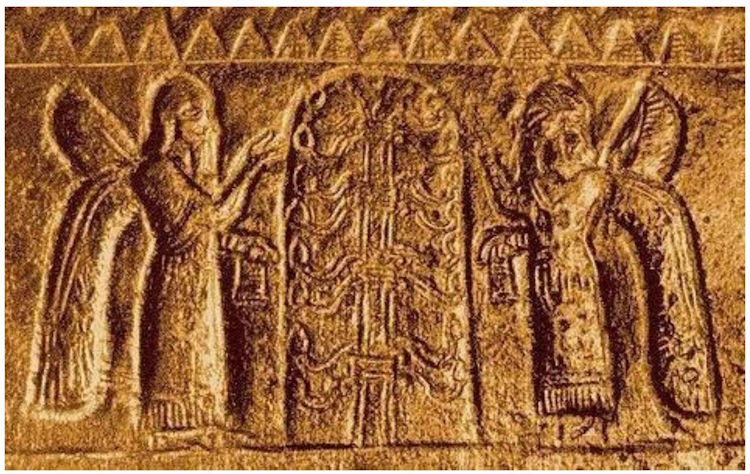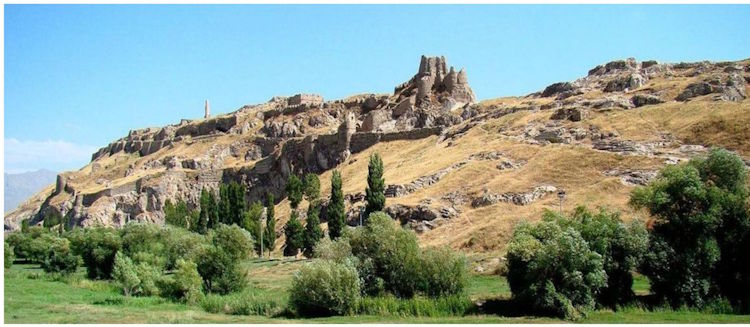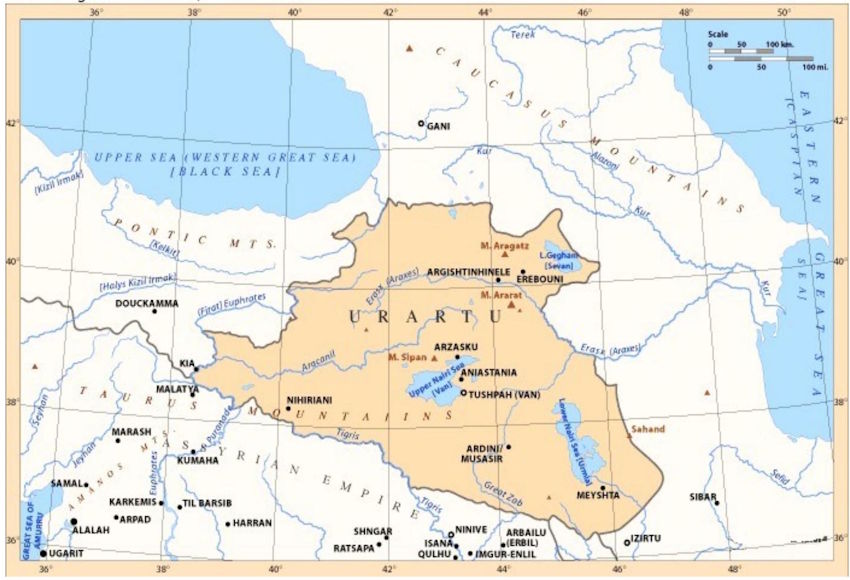© 2022 Troy R. Bishop
© 2022 Jeannie Vasquez, traducción
© 2022 Urantia Association of Spain
By Troy R. Bishop
(Translated by Jeannie Vázquez)
At the dawn of the twentieth century, a long-forgotten culture was rediscovered in the Anatolian highlands of Asia Minor. This ancient civilization, Urartu (pronounced u-rar’-tu), centered on Lake Van, flourished from the ninth to the sixth century BC, stretching from Lake Urmia in the east to northern Syria in the west. During its three hundred years of existence, the Urartian Empire was a formidable power. Later, it was defeated and disappeared from human memory.
¶ Featured Predecessors Revealed
The land occupied by the Urartians has played a prominent role in the eternal universal ministry to our planet, which has been revealed in The Urantia Book. The pendulum of world destiny swung in that direction long before modern man remembered.
Two hundred thousand years ago, Van, an ascending (rematerialized) volunteer who came to Urantia, heard Caligastia, his superior and celestial ruler of our planet, announce a plan to reject the Paradise rule of the Father and the Creator Son. Van, who had worked in the city of Dalamatia, Caligastia’s headquarters, for three hundred thousand years according to the plan for world advancement, vigorously denounced the rebels. With Amadon, his modified Andonite associate, he gathered a small band of loyalists and retreated to a nearby unwalled settlement. Each of the seraphim, cherubs, midway creatures, Life Carriers, ascending corporeal volunteers, modified Andonites, and other loyal beings separated from the authority of the Planetary Prince and from the tasks they had performed for three hundred thousand years to choose the truth of the primacy of the Universal Father, rather than follow the comfortable path of obedience.
Although darkness and death reigned outside the settlement, the loyal midwayer sentinels were ever vigilant. Van and Amadon possessed the priceless Tree of Life, which had been appropriated by the loyal cherubim, seraphim, and midwayers at the outbreak of the rebellion. By partaking of the fruit and leaves of this tree, within which superhuman energies circulated, these two beings, whose bodies contained the organic complement of the life circuits of the Satania system, were able to live indefinitely. Those of their loyal material and semimaterial comrades whose bodies were similarly constituted were also capable of immortal existence. Their former disloyal companions in Dalamatia, however, finding themselves lacking this life-giving ministry, faced disintegration and inevitable death.

The outbreak of the rebellion had imposed silence on the interplanetary circuits due to the quarantine. For seven anxious years, the loyalists waited to learn their status with the universe authorities. Finally, a messenger arrived, bearing news vindicating their actions in defying the Prince. Leaving the ancient city of promise, which lay (possibly) at the (then) mouth of the Persian Gulf, behind them forever, the group traveled across the expanse of the Mesopotamian plain to the rugged wall of the bordering highlands. Leaving the dust of Mesopotamia behind, they entered the highlands, to their rendezvous with destiny.
Shortly after this relocation, all of Van and Amadon’s loyal material and semimaterial associates of immortality were removed from Urantia to the system capital, and Van was designated the supreme authority over all superhuman personalities on Urantia. From these isolated highlands, over a period of one thousand years, Van and Amadon established 350 settlements of people loyal to the plan of mortal progression and universe cooperation. This network extended from Lake Van eastward to the southern Caspian Sea region and to the foothills of Kopet Daugh in Turkestan, and we are informed in The Urantia Book that this was the eastern terminus of the Vanite network and also the principal headquarters of Van and Amadon.

For 150,000 years, Van and Amadon led the highland descendants of their original human followers in their efforts for the upliftment of the world. For untold generations, legends arose about these two immortal ministers of God who continued to live and work among men. Gradually, Van and Amadon came to be seen as divine or near-divine personages and were incorporated into the traditions, superstitions, and religions of humanity.
After the sending of a Material Son and Daughter to Urantia had been approved on high, Van and Amadon led their followers in preparing a garden for the pair. Thirty-seven thousand years ago, Adam and Eve arrived and assumed the administration of Urantia. Van and Amadon had transplanted the tree of life to the Garden of Eden for the use of the Adamic pair. Shortly after the arrival of Adam and Eve, Van and Amadon returned to system headquarters after nearly half a million years of service on this small and needy world, leaving behind a truly living legacy.
¶ A land forgotten by history
The first recorded mention of Urartu is in ancient Assyrian inscriptions from the 13th century BC, a time before Urartu was consolidated as a state. At that time, the Assyrians applied the term Uruartri to the scattered groupings of people in the region where Urartu was later to appear. The Assyrians also referred to these peoples as the Nairi. (Could this be related to the Nerites mentioned in The Urantia Book, chapter UB 78:8.11?)
In 860 BC, the Urartian kingdom was formed under its first king, Aramu, and the Assyrians began referring to the new nation as Urartu. The Urartians, however, referred to their country as the land of Biaini. Scholars somehow derive the word Van, as in Lake Van (and perhaps nearby Lake Sevan), from the word Biaini and sometimes refer to Urartu as the Kingdom of Van.
The Urartians were overthrown in 590 BC by the Medes and some other peoples formerly under Urartian rule. After the destruction of Urartu, a strange thing happened: other empires that have disappeared from the scene of human affairs have survived in history—the Assyrians, for example; but the vanished civilization of Urartu was completely forgotten. Its greatest successes were attributed to its enemies. Its name was lost to the world, except for certain Assyrian inscriptions, which constituted a puzzle to later historians.
The ancient Hebrews knew the Urartians and had dealings with them, but the Old Testament mistakenly refers to them by a distorted name. Similarly, the name of a mountain vital to Hebrew tradition has been altered through the distortion of the name Urartu. Professor Boris Petrovsky, a researcher of the Urartian Kingdom, writes about the Hebrew distortion of the name Urartu as follows:
“The name was preserved in the Old Testament in the distorted form ‘Ararat’, which in the Latin version became ‘Armenia’. When the Masoretic writers were vocalizing the text of the Bible, they inserted the vowel a into words that were unknown to them, so that ‘Urartu’ became ‘Ararat’; and it is only in very recent years that the Qumran scrolls have provided a form of the name with the semi-vowel w in the first syllable.”
Two Old Testament references to the Urartians are described by Professor Petrovskii as follows:
- “A passage from the Book of Jeremiah dating from the fourth year of the reign of King Zedekiah (i.e., 594 BC) speaks of summoning against Babylon the Medes, the Urartians (‘Ararat’), the Mannaeans (‘Minni’), and the Scythians (‘Aschenaz’).”
- “The Old Testament preserves a memory… that the sons of Sennacherib, after having killed their father, fled to Urartu (the ‘land of Ararat’ or ‘land of Armenia’)”
Today, almost every biblical atlas includes Urartu in its maps of the ancient world and explains that Ararat in the Bible actually refers to Urartu.

Professor Seton Lloyd, another Urartu researcher, states this about the ancient civilization:
“Urartu now appears to us as a nation, and in its time a great nation, whose history and even identity seem to have been completely erased from the records of human memory for 2,500 years. Yet today, everything related to this nation—its racial characteristics, its political and economic history, and its art—constitutes one of the most intriguing problems in Near Eastern archaeology.”
¶ Urartian culture
It is generally accepted that the Urartians arose from the Hurrians and used a language similar to Hurrian. These mountain dwellers built great fortresses overlooking the Urartian highlands. Their kingdom promoted massive construction programs. Palace remains show evidence of economic power. Much of their art has been recovered, particularly bronze works. Urartian art contains abundant representations referring to the Tree Cult—images of sacred trees guarded by seraphim and genies, and sometimes accompanied by a king or kings.
This persistent representation of the Tree of Life with its celestial guardian beings permeated Urartian culture. For generations, personal seals imprinted the sacred tree on correspondence carried throughout the empire. Rulers and administrators drank wine from bronze cups stamped with the tree’s emblem. Urartian warriors wore the symbol of the sacred tree into battle, on bronze belts and pointed helmets. Carved stones displayed the sacred tree symbol throughout the land. Colorful wall paintings and carved columns on palaces and other buildings repeated the recurring theme.
The Urartians were formidable in warfare. The Assyrians undertook attacks against Urartian strongholds, but there were periods when they were careful to cultivate the goodwill of these mountain dwellers. In 714 BC, for example, Sargon, leading his Assyrian army, sacked some Urartian strongholds; but in 654 BC, the Assyrian king Ashurbanipal, celebrating his victory over King Teuman of Elam and the capture of Susa, received emissaries from King Rusa of Urartu. According to the Assyrian annals recording the event:
“Rusa, king of Urartu, heard of the power of my gods and was overcome with terror at my majesty. Then he sent his princes to Arbela to bring me greetings.”
In 590 BC, Urartu was sacked and burned. Only a few vestiges remained. The dust and winds of time did their work. It wasn’t until about a hundred years ago that researchers began to connect ruins throughout the Anatolian highlands with the vague references to Urartu in Assyrian records; they had previously been believed to be Assyrian. It wasn’t until 1936 that the first systematic excavation of a major Urartian fortress began.
After the disappearance of Urartu as a political entity, the Armenians dominated the former highlands, absorbing portions of the earlier Urartian culture in the process. More recently, the Armenians, like their Urartian predecessors, have faced tragic devastation that reduced the population in these ancestral lands. The hand of fate seems not to have yet completed its drama of violent readjustment in the Anatolian highlands.
¶ Some questions
A casual reading of The Urantia Book might give the impression that Van’s headquarters were primarily in the area of Lake Van. A closer analysis and comparison of statements in The Urantia Book indicates, however, that Van’s main headquarters were in the foothills south of the Kopet Dag, where Adamson later settled. In this regard, The Urantia Book explains that the Vanites (Van’s earliest followers) and their descendants later settled on the shores of Lake Van, and their subsequent traditions developed around this area.
It would be interesting to speculate about the racial composition of Van’s early followers and their relationship to the better-known peoples of today—the Armenians, for example. This is a topic for another study. We know that the human followers of Van and Amadon who subsequently reproduced—the non-immortal individuals—were of the Andonite race, as were their modified human followers, none of whom reproduced. We also know that the ascending corporeal volunteers resembled their modified associates, at least in their skin color. The bodies of these rematerialized volunteers were of the same order as the body of Machiventa Melchizedek, who was also provided with a specially manufactured body for his emergency planetary service; in his appearance, Machiventa Melchizedek resembled the people around him, but he possessed a commanding presence. The early Andonites, half a million years before Van and Amadon, somewhat resembled present-day Eskimos in both general appearance and skin color. We do not know how many changes occurred in the Andonite race during the half million years before the time of Van and Amadon. The Nodites, being descendants of the modified Andonites, underwent some changes due to artificial mutations, but they may have maintained a skin color similar to that of the Andonites. The Adamsonites, who later appeared in the Turkestan region formerly inhabited by Van and Amadon, were the ancestors of the early Greeks.
Events of great significance have occurred in that small area of the world, the consequences of which have reverberated through the centuries. Perhaps someday we will know more about this subject. One thing is becoming increasingly clear: The modern revelation contained in The Urantia Book is not merely a theoretical article of belief that must be protected from all ties to external reality. Even the word Urantia, which we readers of The Urantia Book know as the name of our planet, is not, as it now appears, new to this world (a possibility that gives a comforting sense of continuity with the past). The similarity between Urantian and Urartian is too great, the ubiquity of its prefix too universal. Perhaps someday scholars will find a new inscription or discover a new linguistic datum and prove that the exact term Urantia has been in widespread use on our world for ages upon ages.
The word Urantia, the revealed universal name of our planet, was known to Van. Derivatives of this word have abounded in the area where Van resided, making their way into the languages and traditions of men since time immemorial. Some are obvious, while others are speculative: Urartu - Ur - King Ursa - Ural Mountains. Perhaps it is a mistake to look to ancient definitions of the word Ur and its derivatives for clues to the meaning of the name Urantia. Perhaps, as a revealed name, this word has given all human languages their various and imperfectly perceived interpretations of the true universal significance of the prefix Ur.
It may seem strange that the Urartians referred to themselves as Biaini and not Urartians, but 150,000 years of fraternizing with an immortal, even a visible one, seems to be a valid experience to honor in one’s racial and cultural name. It may also seem strange that it was the Assyrians who used the word Urartu. But The Urantia Book, a masterpiece of consistency, has answers to many questions as they arise, even those that were not humanly foreseeable at the time of its writing. One small sentence among the more than a million magnificent words in this book simply informs us that the first Vanitas were the ancestors of the Assyrians.